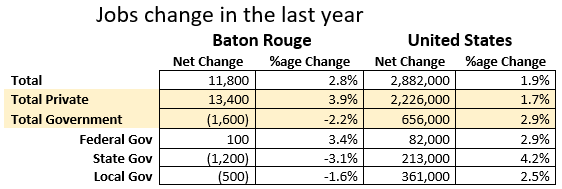The Private Sector is Fueling Job Growth in the State Capital
Two land grant universities and the seat of state government are key assets for the Capital Region, but government jobs are actually down as the metro’s job count continues to rise
Of the 199,000 jobs created across the United States in November, about 25% of them were government jobs. National job growth over the last year, while positive, has been increasingly reliant on government employment: about 22% of national employment growth between April and July 2023 came from the government sector; between August and November 2023, that share increased to 29%. Of the almost 2.9 million jobs created since last year, 656,000, or 23%, have been government jobs1.
One might think the Baton Rouge metro, home of Louisiana’s state capital and two public universities (including the state’s largest), has been subject to similar trends. But that’s not the case: the number of government jobs across the Capital Region actually fell by 1,600 over the last year while private sector job counts increased by 13,400. Government jobs, which include federal, state, and local government employment, have declined in the Baton Rouge metro by more than any other sector since October 2022. This makes government one of just three high-level sectors with fewer jobs today than a year ago. In contrast to national trends, recent job growth in Baton Rouge has not been dependent on the government sector2.
Government jobs as a share of the region’s total employment has been declining for years. Today, federal, state, and local government employment accounts for 16.8% of total Capital Region employment, down from 18.7% four years ago. During that time, the number of private sector jobs has increased by 19,900 while government employment has fallen by 5,300. While federal government largesse has led to increased headcounts for local, state, and federal government across the country, the Capital Region has experienced significant job growth concentrated entirely in the private sector3.
The region’s growing private sector
About 37,000 of Louisiana’s 90,000 state employees work in Baton Rouge. While 37,000 is a lot of state workers – more than triple the number in the New Orleans metro – it’s the fewest number of state workers employed in the Capital Region in the last 22 years4. Employment in local government, which includes public schools, city-parish departments like BREC, and law enforcement agencies like BRPD, numbers about 31,000. A few thousand workers in Baton Rouge are employed by the federal government, but that leaves about 354,000 regional workers who are employed in the private sector. In short, the private sector makes up the bulk of regional employment5.
In October, about 83% of the region’s employed population had a job in the private sector, just below the national average. Not only is private employment as a share of total employment up by about seven percentage points since 1990, but the difference between Baton Rouge and the national average is tightening. The private employment share in Baton Rouge was seven percentage points below the national average in 1990. Today, it’s lower by just two percentage points6.
State government employment in the Baton Rouge metro is down almost eleven percent in the last four years; local government employment, too, is down more than seven percent since mid-2019. Baton Rouge, the region with the rosiest economic forecast among all Louisiana metros, can thank its private sector for its robust performance of late and its projected growth in the short- and long-term.
Diversifying its industry base and reducing its reliance on government employment is good for Baton Rouge, but being home to Louisiana’s largest number of state workers isn’t a bad thing. Regions home to larger government workforces can better insulate themselves against economic downturns. State agencies and higher education institutions also require a lot of highly skilled workers. Many of the faculty and researchers hired by the region’s higher education institutions make valuable contributions to the private sector by way of applying for and receiving federal dollars for research, commercializing their research, and by consulting with private businesses.
And, of course, none of this is to say that the government plays no role in helping create private sector jobs. For example, public works and civil construction projects bid out to private contractors which often tap into money managed by or allocated to state agencies. But when it comes to job growth, it’s the private sector that has stepped up in recent years. There are about 15,000 more jobs in Louisiana’s Capital Region today than there were four years ago, and all of those are private sector jobs.
Source: Bureau of Labor Statistics
Source: Bureau of Labor Statistics. Job counts are from October 2022 to October 2023. Job counts for October 2023 are preliminary.
Source: Bureau of Labor Statistics
Source: Bureau of Labor Statistics. Accessed through the Federal Reserve Bank of St. Louis. Numbers are seasonally-adjusted
Source: Bureau of Labor Statistics, Louisiana Workforce Commission. Accessed through the Federal Reserve Bank of St. Louis
Source: Bureau of Labor Statistics, Louisiana Workforce Commission. Accessed through the Federal Reserve Bank of St. Louis






